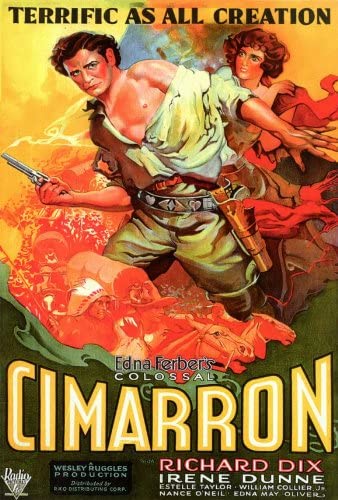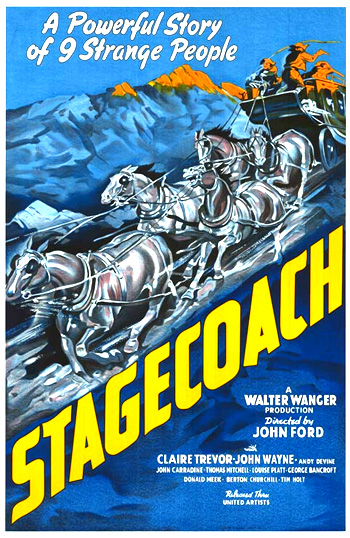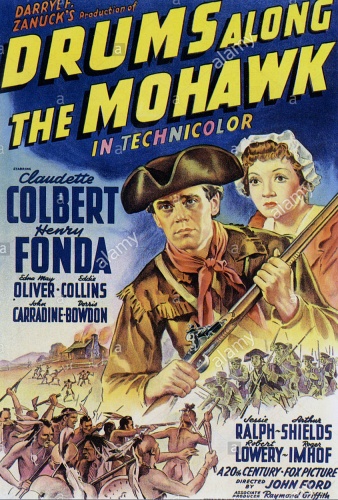THE American WESTERN
By Jeffrey-Baptiste Tarlofsky
By Jeffrey-Baptiste Tarlofsky
Lesson 27 consists of 6 video lectures and transcripts of those lectures, and 5 film excerpts. Start with the lecture, Part 1 and continue down the page in sequence until you reach the end of the lesson.
レッスン27は、6本のビデオレクチャー(レクチャーのテキストがビデオレクチャーの下に記載されています)と5本の動画で構成されています。
このレッスンは、最初のLecture Part 1から順番に動画を見たりテキストを読んでください
Part 1 – Westerns were not considered “serious” films during the Silent Era of film making in America (1895-1927). Most Westerns were for children or young adults and there was little attempt at complex storytelling or character development. The first time a Hollywood Western truly impressed the critics was Cimarron (1931). As I said at the beginning of the course, it so impressed the Academy of Motion Picture Arts and Sciences that it won the Academy Award for Best Picture beating out much better films such as Charlie Chaplin’s City Lights and James Whale’s Frankenstein. The Academy loved the epic quality of the film. But later generations have come to see the film as very uneven. One of the main criticisms of the film has been its racist portrayal of Black characters. This is a legitimate criticism. But calling the entire film “racist” is incorrect. Cimarron was, for its time, a very progressive film and especially so in how it treated minority groups and women. It is Cimarron, for example, not Stagecoach, which first introduces the standard Western character of the prostitute with the heart of gold. (Dixie Lee). It is in the excerpt that we will see now that both the worst racist stereotypes and the most progressive attitudes about race, religion, and sex can be seen.

Directed by Anthony Mann
Produced by Edmund Grainger
Screenplay by Arnold Schulman
Based on Cimarron 1929 novel by Edna Ferber
Starring Glen Ford, Maria Schell, Anne Baxter, Harry Morgan
Music by Franz Waxman
Running time: 147 minutes
Budget: $5,421,000
Part 2 – What we see first is the young boy Isaiah imitating the hero, Yancey Cravat. At the time the film was made it was considered harmless ‘fun” to portray Black characters as childish, bumbling, incompetent, silly, or foolish. Today we consider this offensive racist stereotyping and not a bit funny. However, in the next part of the excerpt we see the “Madam“, Dixie Lee, and her “girls” enter the tent and find their places among the other members of the community. In Stagecoach, Dallas was shunned in her town by the Ladies of the Law and Order League, but in this town, which is still new and “wild”, the prostitutes are accepted as part of the community (even though they are whispered about). Later in the film, after the town becomes more “civilized”, Dixie Lee is arrested and charged with “being a public nuisance“ (a euphemism for “prostitute”). Yancey, who is also a lawyer, defends her in court and wins her acquittal.
Then there is the Jewish peddler, Sol Levy, who asks if he is allowed to be at the meeting. Again, Yancey makes sure he feels welcome. But the most surprising moment in the entire film is when Yancey calls on everyone to contribute some money to help buy the new church organ…except the Indians. He says they don’t have to pay anything because the white man has already stolen enough from them already. That was an astounding thing to say in a 1931 film*. Remember that in 1931, there was widespread and very serious discrimination against the Indians. Almost no white Americans knew the true history of how their ancestors had stolen the land from the Indians and if they did know it they believed the theft was justified because the Indians were just “savages”. The scene is brief, yet it is quite a remarkable moment in film history. This is the only Western film I have been able to find before about 1953 in which a white man openly admits that his people have stolen the Indians’ lands. In this sense, Cimarron is a far more honest film than John Ford’s Stagecoach. Stagecoach is a brilliant film and one of the very greatest Westerns ever made, but when Ford depicts the Indians in Stagecoach he badly distorts history.
*Cimarron is as progressive for its time as The Man Who Shot Liberty Valance would be in its time thirty years later. In fact, the scene in which Prostitute and Lady, Jew and Gentile, White and Indian are all under one roof is reminiscent of Ransom Stoddard’s school where everyone is welcome.

Directed by John Ford
Produced by Walter Wanger
Screenplay by Dudley Nichols
Based on “The Stage to Lordsburt” by Ernest Haycox
Starring John Wayne, Claire Trevir, Andy Devine, John Carradine
Music by Richard Hageman, Franke Harling
Running time: 96 minutes
Budget: $1,103,757
Part 3 – Throughout the journey, the people on the stagecoach are in constant fear of an attack by the Apaches led by Geronimo. This is actually how we are able to date the time of the film to about 1883 because this was the time Geronimo was most active. I have already mentioned that the shot of the Apache coming down the hill to attack the stagecoach influenced Akira Kurosawa when he made Seven Samurai. The Apache attack does not even seem to be a human thing, but more like a force of nature. We don’t really understand why the Apache are attacking except that they want to kill the white people. No reason or justification is given for the attack. It seems irrational, as if the Apache were like a pack of wolves. But no pack of wolves would continue an attack after so many members of the pack were killed or wounded. A total of sixteen of the Apache are shot and either wounded or killed chasing the stagecoach, which only has ten people on board counting the baby. Yet, the real Geronimo only led a group of about fifty warriors at any one time. In other words, the attack is not only irrational it is very bad military strategy. If there was one thing everyone agreed on regarding Geronimo, it was that he was a brilliant military strategist. He would never have wasted so many of his men in such a futile attack.
In fact, nothing like this kind of attack was ever recorded in history. This is purely a “Hollywood” event. It is very exciting and wonderful film making with its many exciting stunts, but it is historical nonsense. So, my first point about Hollywood films and the Indians is that the films were usually very inaccurate accounts of history. Stagecoach certainly was.
Another important thing that happens during the attack is the behavior of Hatfield the gambler. Hatfield actually came on the trip to, as he said, “offer my protection to this lady”. Throughout the film he has been Lucy’s friend and protector out of a sense of chivalry. Hatfield tells Lucy that he served in her father’s regiment in the army during the Civil War. Protecting the daughter of his old Commander is, of course, the way he will achieve the redemption he seeks from whatever crimes or sins he has committed that forced him to leave home and change his name. So, why is it that just as their situation seems most desperate, Hatfield suddenly turns his gun on Lucy and seems to be preparing to kill her? Yes, it is because he fears what the Indians will do to Lucy more than anything else, and the chief fear is of rape.
The image of the Indian created by Hollywood films was that of a completely uncivilized people who engaged in killing, rape, and torture. But there was in Hollywood films a special emphasis placed on the fear of rape. Why? Throughout history rape has been used as a weapon of war. When two nations fight wars there is always the threat that the victorious army will not only kill the soldiers of the losing side but that they will rape the women. Rape is a form of terror. It sends a message to the enemy soldiers: “you are too weak to protect your wives, mothers, and daughters”. But for the white European invaders of America, the fear was also deeply rooted in their racism. A white woman taken captive alive by Indians might not only be raped but might eventually give birth to a racially mixed child. To the whites, this represented the ultimate degradation. Therefore, they believed that a white woman would be better off dead than risk being taken prisoner by the Indians. Hatfield is prepared to kill Lucy rather than allow her to be captured. But just as he is about to kill her, he himself is shot and killed. At that very moment, Lucy hears the bugle blowing the cavalry charge. The curious thing about Hatfield’s death scene is that Ford makes it such a redemptive one. Hatfield just has time to say, “If you see Judge Greenfield, tell him his son…” and Hatfield dies, but he has redeemed himself. Nobody in 1939 questioned whether killing Lucy was the right thing for him to try to do. It was simply assumed that he was saving her from unimaginable horrors.
The very same year John Ford made Stagecoach, he made another film which was not, technically speaking, a Western at all. But I am going to show it to you because it is about the Indians. The film, Drums Along The Mohawk (1939), is set during the American Revolution of 1776. It is the story of how a young colonial-era couple, Gil and Lana, survive in a frontier village of the time. We first see Gil and Lana getting married and then we see them traveling west to their new home in the village of Deerfield, Massachusetts.

Directed by John Ford
Produced by Darryl F. Zanuck (executive producer)
Screenplay by Sonya Levien & Lamar Trotti
Based on Drums Along the Mohawak 1936 novel by Walter D. Edmonds
Starring Claudette Colbert, Henry Fonda, Edna May Oliver, John Carradine, Ward Bond
Music by Alfred Newman
Running time: 103 minutes
Budget: $2 million
Part 4 – Gil’s attempt to comfort Lana by telling her that Blue Back has become a Christian, (as if Christians never committed murder or rape) is really his way of trying to tell her is that he is in the process of giving up his own culture and religion and adopting white culture and religion. This was another way in which the white Europeans destroyed Native American cultures through “assimilation”. Assimilation is the process by which a person or a group’s language and/or culture come to resemble those of another group. Blue Back seems willing to assimilate, but in many cases, white Americans practiced “forced assimilation” against the Indians. Indians were forced to practice Christianity, dress in Western clothes, speak English, attend special schools set up for them by missionaries, give up hunting, and take up farming. To be fair, the whites doing this believed they were “civilizing” uncivilized people and forced assimilation was certainly relatively less horrible than committing outright genocide. But the term “cultural genocide” is another way of describing what “forced assimilation” is and the term is probably more accurate. The whites were not attempting to turn the Indians “white” because their entire idea of “whiteness” was tied to their racist ideology. Even Indians who spoke perfect English, wore Western clothes and farmed the lands as white settlers would never be granted the same rights as whites. Assimilation was just another way of removing the Indians as an obstacle to white rule by destroying their culture.
By the way, white Americans are hardly the only people to do this. The practice of cultural genocide has been widespread throughout human history and is still being actively practiced today. In Chinese occupied Tibet and the Western province of Xinjiang, the Tibetan and Uyghur cultures respectively are being systematically wiped out by the Chinese Communists who are committing cultural genocide in almost exactly the same way the white Americans did against the Indians. When I was in Tibet I witnessed this happening first hand although my Chinese guides tried to explain that Tibet was being “developed “and the Tibetans “educated”. For example, if the new hotel where I was staying in Lhasa was built for the benefit of the Tibetans why was it that no Tibetans were allowed in the hotel?
But to return to Drums on the Mohawk, Lana’s terror is not an exaggeration. White people throughout American history were taught to fear Indians. To be fair, the conflict with the Indians was very real and atrocities were committed on both sides. But let us remember that one side was the invader and the other side the invaded.
Moreover, the fear of the Indian was something that did not disappear once the Indians had been defeated. Hollywood kept this fear alive. As a little boy, I remember being especially afraid of three things: werewolves, space aliens, and Indians. In all three cases, I learned to be afraid of these things by watching Hollywood movies. But while werewolves and space aliens were not real, Indians are real. They were real people but the movies taught me to fear them as if they were like werewolves or space aliens. Fear is, of course, the origin of prejudice and discrimination. As a little boy, I was afraid of Indians even though I had never met one. I would not meet any actual Indians until I was in university and started studying Native American history and culture. The first time I ever met an Indian was when I was a first-year university student and a very tall, well-dressed woman walked into the classroom and said “I am Professor Rogers”. She was from the Navaho tribe. I wonder if you had a similar experience? Was the first time you met a gaijin in a university classroom?
As a university student, I was soon to get to know Indians a lot better. In fact, I dated two Native Americans while I was a student. The quickest way to lose your fear of people is to just get to know them. This is what meeting real people does. It makes us realize that we are all just people and not characters in a movie.
Later in the film, Lana has stopped being afraid and has started to love her new home. But just as all seems to be going so well, disaster strikes
Part 5 – What we see in this scene is very similar to what Ford showed us in Stagecoach. The Indians come out of the wilderness as if they were a force of nature. The contrast between the whites and the Indians could not be stronger. The white people are shown as peaceful farmers, they are also shown as individual people: men, women, children. The Indians are all warriors, all armed men with fire and weapons and they only want to destroy the settlers’ farms and burn their homes.
I should add that this battle is very loosely based on a real raid that took place against the town of Deerfield, Massachusetts in the year 1704 when the French and British were at War in North America. The French encouraged and helped the Indians to attack Deerfield. Ford changes the time to 1776 when the Americans were fighting the British for independence. This is why you see a white man with the Indians. He is a British spy encouraging them to attack the Americans because they have just declared independence. Again, this is historical nonsense.
As one critic put it, “Unfortunately, the 1939 film directed by John Ford, starring Henry Fonda and Claudette Colbert, abandons the historical complexity of the original for the mythic simplification of an all-American Western.” At the time, Ford was far more interested in making exciting movies than in telling the truth about history.
Except for Blue Back, who is an assimilated Indian, we rarely see an Indian in either a medium or a closeup shot or hear them talking, but when we do, it is in scenes like the following:
Part 6 – Again there is the subtle suggestion of possible rape here, but the old lady is what we call “feisty” and she manages to get in a good slap on one of the Indians. But the point is to show us how wicked the Indians are. They will even burn an old lady’s house.
Finally, the whites have taken refuge inside the fort where they can mount a collective defense. Even in the eighteenth century (the 1700s) more than two hundred years after the arrival of Columbus, it was still possible for the Indians to take the initiative and attack the whites and force them to be on the defensive. The reason for this was that while the whites’ muskets and sabers and canon were superior to the weapons the Indians had, they were not yet able to give the whites the overwhelming advantages they would have when they began the conquest of the West after the end of the Civil war. Your homework reading is about the weapons whites and Indians used respectively and how the evolving technology changed the balance of power in the West.